Ultimate Guide to Stucco Inspection: What Homeowners Need to Know
Do you ever wonder why the exterior of your house is so vital? Have you been confused about the significance of assessing your stucco system? If that’s the case, rest assured – you’re not alone. Stucco examinations or inspection services are necessary for every homeowner to guarantee their home remains attractive and performing optimally by not leaking moisture. This post will provide an insight into exactly what a stucco inspection entails: types, processes in appointing professionals. As well as costs associated with addressing issues if found during inspections. So let’s jump right into it!
Stucco is a major element of numerous houses, hence necessitating regular review and caretaking procedures just to keep them looking great at all times. To do this correctly, one has got to go through extensive examination on each aspect included in one’s stucco system which requires professional help from a specialist inspector. After conducting such reviews, fixing any discovered issue would follow thus bearing its own cost requirement also explained herein Finally, we’ll learn how crucial these checks truly are; allowing homeowners to choose when they deem appropriate and eventually become knowledgeable thereof.
- Stucco inspections are important for detecting potential problems and avoiding costly damage.
- Professional stucco inspectors offer comprehensive assessments, with certification and experience ensuring accurate results.
- Regular inspection, sealing of cracks, proper flashing installation can help extend the life of stucco while costs may range from $600 to $1,200 depending on a variety of factors.
Importance of Stucco Inspections
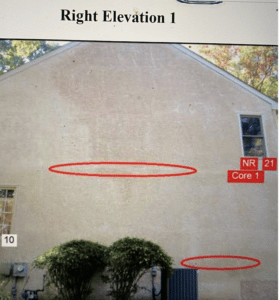
A regular stucco inspection can prevent costly repairs and unexpected damage from moisture. The Stucco Safe process involves assessing the system, examining the exterior with a visual check-up as well as moisture testing and testing resistance to detect any issues before they worsen. For anyone planning on selling or buying property, having this kind of periodic assessment is crucial for maintaining its stately aesthetic integrity. It has been recommended that inspections are done every four years at least in order to spot problems related to home’s outside surface early on, such as hidden damage caused by water accumulation.
Moisture Intrusion
Conducting stucco inspections can be key in identifying moisture intrusion, as this is a silent but potentially damaging issue. If left unaddressed, the effects of water exposure to a house made from stucco can lead to mold and mildew growth on siding or walls inside the home, not to mention structural damage requiring costly repairs. A few signs homeowners should look out for include discoloration, cracking caulking joints, noticeable dampness or an unpleasant odor when around their exterior walls with such material applied onto it. Early detection of these problems allows immediate action which will help avoid destruction down the road caused by infiltration of moisture into one’s property through its Stucco structure.
Hidden Damage
The damage hidden underneath stucco is much like an iceberg, with only the tip seen on top and extensive damage below. Sometimes there are no visual cues of major issues behind the stucco system. If this concealed destruction goes unchecked, it can cause expensive repair bills as well as devalue the property, especially if moisture has infiltrated. To assess these issues earlier rather than later, a thorough investigation of said stucco needs to be carried out using intrusive methods such as drilling holes for examining internal dampness levels within said material. When not addressed in time, signs of deterioration could become visible inside the home, whether that’s structural degradation or stains related to water seepage- plus serious safety risks come into play too!
Types of Stucco Inspections
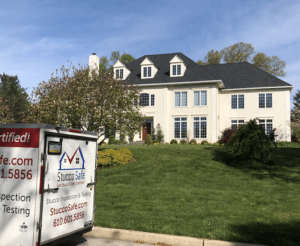
There are three main types of stucco inspections – visual, non-invasive and invasive. A visual inspection consists of identifying the type of stucco used, examining its condition and spotting any potential issues related to incorrect installation. On the other hand, a non-invasive test involves assessing an exterior for signs of physical damage or improper installment techniques while scanning the stucco system with a device like a thermal infra red camera.
Visual Inspection
To start a stucco inspection, an initial visual check is performed. This first step helps to identify existing damage in the form of visible signs such as cracks, discolorations and incorrect flashing. Inspectors look carefully at entrance points on external walls like doors or windows and inspect other spots where water might be directed towards these walls via roofing overhangs during examination of the exterior part. By doing this thorough assessment it can assist in detecting any problems early so that Deterioration does not happen down the road.
Non-Invasive Inspection
A non-invasive inspection is different from a visual check, as it does not cause any damage to stucco. In terms of examining potential issues. Thermal imaging and other methods are employed so that potential elevated moisture levels can be detected without making any alterations to walls or foundations. With this technique, possible points where water may enter become identifiable along with cold patches which could also suggest internal dampness problems. This approach enables inspections for urgent remedial action needed at an earlier stage than ever before due diligence has been done by way of inspection procedures alone previously. The only way to accurately identify issues behind the stucco system is with a full invasive inspection.
Invasive Inspection
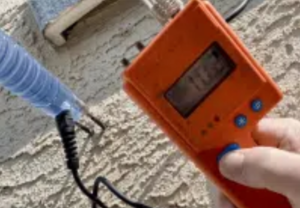
Through invasive stucco inspections, small holes are drilled to measure moisture content and determine the integrity of underlying structures. Utilizing advanced Delmhorst 21-E probes, this technique provides a more comprehensive assessment than non-invasive checks which merely graze over the surface like a submarine would do in open waters. Such readings on water levels offer crucial knowledge when it comes to evaluating how strong an exterior wall may be made up by its protective plaster layer or stucco finishings.
Hiring a Professional Stucco Inspector
When searching for a professional stucco inspector, look out for certifications such as Level I and Level II EIFS Inspector Certification, Moisture Analysis & Quality Control Inspector and Level II Building Envelope Inspector. This will make sure that the person conducting the exterior inspection has an adequate understanding of industry practices and can produce accurate results with their specialized know-how. Stucco Safe inspectors all carry a strong background of experience and certification.
The experienced stucco inspector you choose should be able to provide comprehensive reports along with beneficial recommendations after assessing your home’s façade which allows them to quickly spot potential moisture problems if there are any present. Stucco Safe reports are typically delivered the day following the inspection.
Certification and Experience
Having a professional stucco inspector evaluate one’s home is just as important to homeowners, like hiring an experienced coach is for athletes. That being said, the best assurance of quality and accuracy in inspecting comes from making sure that any certified individual has met certain qualifications prior to taking on such responsibility. These may include certification specifically regarding inspections involving stucco work or having practical knowledge obtained through completion of recognized remediation programs. Experience within this particular industry over multiple years should also be taken into consideration when choosing the right fit for necessary inspection services. Ultimately, these components will ensure proper evaluation based on up-to-date standards is effectively performed by qualified inspectors who can provide insightful advice about current stucco conditions accordingly.
What to Expect During the Inspection
When you invest in a professional stucco inspector, you can be confident that your exterior inspection will run smoothly. The process includes an extensive visual evaluation of the stucco and components like sealants, windows doors flashing and parapets. If necessary, there may also be moisture probe tests on wood framing as well as invasive inspections requiring small holes to inspect internal structures. All these aspects guarantee peace of mind when it comes to protecting against dampness or potential damages caused by excessive moisture levels.
Addressing Issues Found During Stucco Inspection
A stucco inspection is an important step for homeowners to identify any issues that can threaten the integrity of their property’s exterior. This includes detecting moisture intrusion and cracks as early remediation actions need to be taken quickly to avoid Deterioration or damage. Stucco remediation involves several steps, such as conducting a thorough analysis in order detect moisture within framing, sheathing, insulation, treating mold growth, ensuring good drainage/ventilation systems are present along with protection measures so structural soundness remains unharmed by unwanted water infiltration.
Stucco Remediation
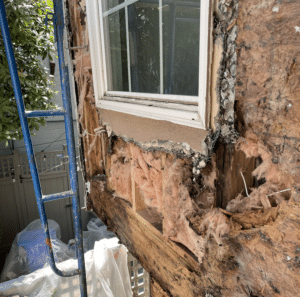
When it comes to stucco remediation, think of the process as a healing remedy for damage to your stucco home. This consists of fixing or replacing any broken components and examining underlying issues such as water infiltration or improper installation that caused said damages.
The treatment includes: assessing the situation at hand, taking off old plaster, eliminating corroded plywood sheathing if needed, executing essential structural work in order to repair correctly all parts affected by wear and tear from elements like wind and rain, utilizing brand-new materials when required, then reinstalling everything back into place so that it can be restored close enough to its original state before Deterioration takes course.
Overall, with this multi-step approach you’re aiming at restoring previous harm done onto your beloved house while also safeguarding against similar future complications occurring again due to weathering factors out there.
Preventative Measures
Proper maintenance of stucco is like providing insurance to the exterior surface of your house. To protect it against future damage and extend its lifetime, you need consistent cleaning, repairing caulk with quality materials for preserving stucco’s longevity.
Periodic evaluations as well as sealing all gaps with suitable materials provide long-term protection for this facade material. These precautionary measures can prevent more significant problems while conserving a good-looking finish on the outside wall covering.
Stucco Inspection Costs
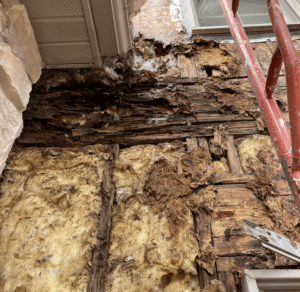
The expense of a stucco inspection is worth the investment as it ensures your home’s long-term durability. Prices for this type of assessment typically range from $600 to $1,200 and may vary based on factors such as square footage or required level of examination and access. It’s essential that all costs associated with an inspection are considered in order to avoid any surprises when factoring costs into the overall budget plan. Ultimately, taking time now for a thorough evaluation will help protect you against future costly repairs down the line.
Factors Affecting Cost
The cost of a stucco inspection is determined by several factors, such as the size and complexity of your house structure, and what kind of review you require. How intricate your home design is can affect pricing too. Extra complex commercial properties often involve more elaborate features that may not be easily accessible for observation (which then adds to the time needed to inspect it correctly) resulting in higher costs compared to simpler constructions.
Summary
Stucco inspections are essential for preserving the aesthetics and integrity of a stucco home. Hiring an experienced inspector to detect moisture intrusion, hidden damage, and other potential issues can save homeowners from costly repairs down the road. Taking preventative measures such as timely remediation will guarantee your exterior is kept in great shape over time. Regular inspections make sure that any concerns around water or rot don’t go unnoticed. They serve as investments in maintaining your property’s value long-term.
Frequently Asked Questions
Why does stucco need to be inspected?
A stucco inspection is critical in order to recognize any potential damage before it becomes worse, which could save significant amounts of money over the long run. Regular examinations should be performed regularly so that the structure remains reliable. Doing these inspections will help preserve a building’s stability and integrity throughout time.
How do you identify stucco problems?
If dark spots around the windows, at junctions between roofs and walls, or visible cracks are present in a stucco surface, then it is important to conduct an inspection. These signs could be indicators of water damage that has occurred on the material. It is crucial for any property owner to carefully examine if these tell-tale indications exist so as to get a clear understanding of how extensive this type of deterioration might have become. Also if your home was built between 1980 and 2021 it may be vulnerable to older building codes that tended to leak even when installed correctly.
How do you test for stucco?
In order to test stucco, two tiny holes are drilled and probed with a moisture meter. The openings must be covered up using silicone caulk to seal them while still matching the colour of their surroundings.
How can you tell if there is water damage behind stucco?
Signs of possible water damage behind the stucco can include discoloration, stains and mold growth with a brownish hue. Examining these indicators on the surface could be helpful in determining if there is any underlying water damage present. Also, interior staining, especially around windows, can be a strong indicator of a major problem.
Why are stucco inspections important?
It is essential to get regular stucco inspections done in order to check for moisture infiltration, unseen damage and protect the longevity of your home’s exterior. Such evaluations are helpful in pinpointing any prospective problems and fixing them quickly before they worsen or become more expensive to take care of.
